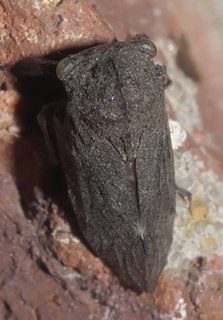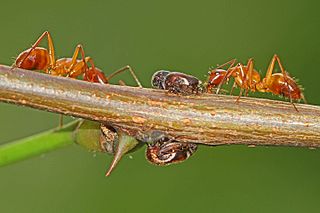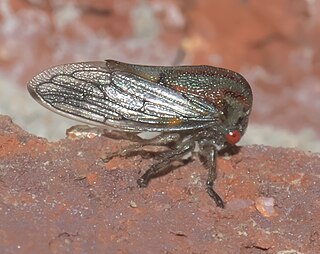
Treehoppers and thorn bugs are members of the family Membracidae, a group of insects related to the cicadas and the leafhoppers. About 3,200 species of treehoppers in over 400 genera are known. They are found on all continents except Antarctica; only five species are known from Europe. Individual treehoppers usually live for only a few months.

The Auchenorrhyncha suborder of the Hemiptera contains most of the familiar members of what was called the Homoptera – groups such as cicadas, leafhoppers, treehoppers, planthoppers, and spittlebugs. The aphids and scale insects are the other well-known "Homoptera", and they are in the suborder Sternorrhyncha. Lesser-known insects largely regarded as Homoptera are the Coleorrhyncha. However, the taxonomic status of the Hemiptera and Homoptera is currently under investigation and discussion. See Heteroptera and Prosorrhyncha for more information.

The superfamily Membracoidea of sap-sucking true-bugs includes two of the largest families within what used to be called the "Homoptera": the leafhoppers (Cicadellidae) and the treehoppers (Membracidae). The other families in this group are quite small, and have, at various points, generally been included as members within other families, though they are all presently considered to be valid, monophyletic groups. The relict family Myerslopiidae is restricted to New Zealand and South America while the Melizoderidae consist of two genera restricted to South America. The great diversity of Neotropical taxa suggests that the group originated in that region.

The buffalo treehopper is a species of treehopper belonging to the subfamily Membracinae. It is also sometimes classified as Ceresa bisonia.

Stictocephala is a genus of treehoppers in the family Membracidae; in the subfamily Smiliinae and tribe Ceresini. Species appear to be distributed mostly in North America, but S. bisonia has become widely distributed in Europe.

Centrotus cornutus (thorn-hopper) is a species of "treehoppers" belonging to the family Membracidae.

Aconophora compressa is a species of insect in the treehopper family, Membracidae. It is known by the common names lantana bug, lantana treehopper, lantana stemsucking treehopper, and lantana sap-sucking bug.

Enchenopa binotata is a complex of multiple species found mostly in Eastern North America, but have also been reported in Central America. They are commonly referred to as treehoppers and are sap-feeding insects. The species in the complex look similar to each other in morphology, but are identified as different species by the host plant they occupy.

Aetalionidae are a family of plant-hoppers or tree-hoppers in the superfamily Membracoidea. Aetalionidae are somewhat like Membracidae in that they have one to three rows of short spines on the hind tibia but differ in having the front femur fused to the trochanter and the scutellum is completely exposed. The females have finger-like protrusions on the genital capsule. The family is mostly Neotropical. The subfamily Biturritiinae is Neotropical while the subfamily Aetalioninae has a Neotropical genus Aetalion and the sole Old World representative genus Darthula with a single species Darthula hardwickii.

Microcentrus caryae, the hickory stegaspidine treehopper, is a species of treehopper in the family Membracidae.

Smiliinae is a subfamily of treehoppers in the family Membracidae. These are bugs and include about 100 genera in 10 tribes.

Thelia bimaculata, the locust treehopper, is a species of treehopper in the family Membracidae.

Thelia is a genus of treehoppers in the family Membracidae. There are at least two described species in Thelia.

Vanduzea is a genus of treehoppers in the family Membracidae. There are about 12 described species in Vanduzea.

Antianthe expansa, known generally as the keeled tree hopper or solanaceous treehopper, is a species of treehopper in the family Membracidae.

The Brazilian treehopper is a species of insect belonging to the treehopper family (Membracidae). It has unusual helicopter-like features. While Bocydium can be found throughout the world, they are most prevalent in Africa, North and South America, Asia and Australia. They exhibit limited movement and their primary food source is from the underside of leaves. They also exhibit hemimetabolous development.

Bocydium is a genus of insects in the treehopper family, Membracidae. A 1999 classification identified 14 species in the genus, distributed around the Neotropics.

Platycotis is a genus of treehoppers in the family Membracidae. There are about 13 described species in Platycotis.

Platycotis vittata, the oak treehopper, is a species of treehopper in the family Membracidae, found in North America. The species is also called Platycotis vittatus.

Kaikaia is a genus of treehopper endemic to Nicaragua, containing the single species Kaikaia gaga. It was described in 2020 by Brendan Morris, a Ph.D. student at the University of Illinois at Urbana-Champaign. It entered the news when it was revealed that the insect was named after Lady Gaga.
















